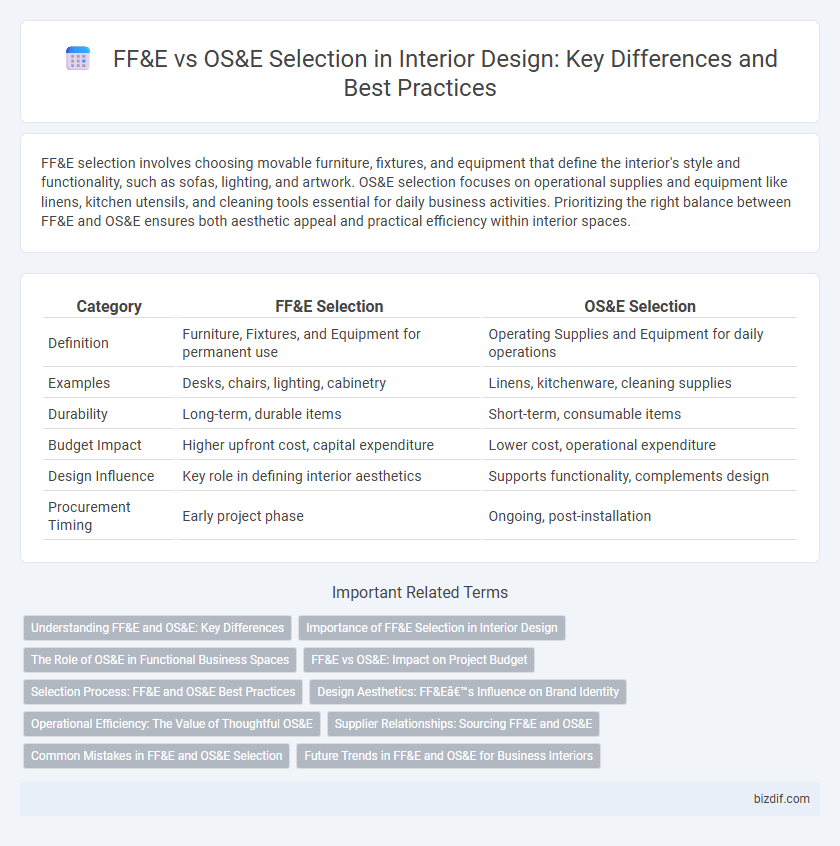FF&E selection involves choosing movable furniture, fixtures, and equipment that define the interior's style and functionality, such as sofas, lighting, and artwork. OS&E selection focuses on operational supplies and equipment like linens, kitchen utensils, and cleaning tools essential for daily business activities. Prioritizing the right balance between FF&E and OS&E ensures both aesthetic appeal and practical efficiency within interior spaces.
Table of Comparison
| Category | FF&E Selection | OS&E Selection |
|---|---|---|
| Definition | Furniture, Fixtures, and Equipment for permanent use | Operating Supplies and Equipment for daily operations |
| Examples | Desks, chairs, lighting, cabinetry | Linens, kitchenware, cleaning supplies |
| Durability | Long-term, durable items | Short-term, consumable items |
| Budget Impact | Higher upfront cost, capital expenditure | Lower cost, operational expenditure |
| Design Influence | Key role in defining interior aesthetics | Supports functionality, complements design |
| Procurement Timing | Early project phase | Ongoing, post-installation |
Understanding FF&E and OS&E: Key Differences
FF&E (Furniture, Fixtures, and Equipment) encompasses movable items such as chairs, desks, lighting, and artwork essential for interior functionality and aesthetics, while OS&E (Operating Supplies and Equipment) includes consumable or replaceable items like linens, kitchen utensils, and cleaning supplies critical for daily operations. FF&E items are typically capital expenditures with longer lifespans, whereas OS&E involves operational expenses subject to frequent replenishment. Understanding the distinction between FF&E and OS&E is vital for effective budgeting, procurement, and project management in interior design.
Importance of FF&E Selection in Interior Design
FF&E selection plays a critical role in interior design by defining the aesthetic, functionality, and comfort of a space through furniture, fixtures, and equipment that are integral and durable. Unlike OS&E, which includes operational and consumable items, FF&E contributes long-term value and is essential for creating cohesive and inviting environments. Prioritizing FF&E ensures the design vision is fully realized while meeting practical needs and enhancing user experience.
The Role of OS&E in Functional Business Spaces
OS&E (Operating Supplies and Equipment) selection in functional business spaces plays a crucial role in ensuring operational efficiency and customer satisfaction by providing essential everyday items such as linens, tableware, and cleaning supplies. Unlike FF&E (Furniture, Fixtures, and Equipment), which focuses on the physical and aesthetic elements, OS&E is directly linked to daily business activities and service delivery. Proper OS&E selection enhances workflow, supports staff performance, and upholds hygiene and safety standards in hospitality, offices, and retail environments.
FF&E vs OS&E: Impact on Project Budget
FF&E (Furniture, Fixtures & Equipment) selection typically represents a larger portion of the project budget compared to OS&E (Operating Supplies & Equipment) due to higher costs associated with durable, long-term assets. While FF&E involves substantial upfront investment impacting capital expenditure, OS&E primarily affects operational budgets with ongoing replenishment costs. Strategic balance between FF&E and OS&E selections ensures optimal allocation of resources, preventing budget overruns and supporting project financial sustainability.
Selection Process: FF&E and OS&E Best Practices
FF&E selection focuses on durable, fixed assets like furniture, fixtures, and equipment, emphasizing quality, functionality, and aesthetic harmony with the overall interior design scheme. OS&E selection involves operational items such as linens, tableware, and small appliances, prioritizing usability, compliance with safety standards, and ease of replacement. Best practices include conducting thorough needs assessments, supplier comparisons, and integrating budget constraints with design intent to ensure cohesive and efficient procurement workflows.
Design Aesthetics: FF&E’s Influence on Brand Identity
FF&E (Furniture, Fixtures, and Equipment) selection plays a crucial role in defining a space's design aesthetics and reinforcing brand identity by incorporating cohesive styles, materials, and color palettes that reflect the brand's personality. OS&E (Operating Supplies and Equipment) focuses more on functional, operational items that do not significantly impact the visual or thematic consistency of the interior design. Prioritizing FF&E ensures a strong, immersive environment where every element contributes to the overall brand experience and customer perception.
Operational Efficiency: The Value of Thoughtful OS&E
Thoughtful OS&E selection significantly enhances operational efficiency by ensuring all necessary items, from kitchenware to linens, are tailored to the specific needs of the facility, reducing delays and minimizing replacement costs. Unlike FF&E, which focuses on the aesthetic and functional elements of furniture, fixtures, and equipment, OS&E directly impacts daily operations and guest satisfaction. Prioritizing precise OS&E choices streamlines workflows, improves staff productivity, and supports long-term cost savings in hospitality and commercial interiors.
Supplier Relationships: Sourcing FF&E and OS&E
FF&E (Furniture, Fixtures & Equipment) selection requires building long-term supplier relationships to ensure consistent quality and timely delivery of durable goods such as furniture and lighting. OS&E (Operating Supplies & Equipment) sourcing focuses on flexible, cost-effective partnerships for frequently replenished items like linens, kitchenware, and consumables. Effective supplier management in both categories optimizes project timelines and budget control while maintaining high operational standards.
Common Mistakes in FF&E and OS&E Selection
Common mistakes in FF&E selection include neglecting durability and functionality, leading to frequent replacements and increased costs. In OS&E selection, overlooking compatibility with operational processes often results in inefficiencies and workflow disruptions. Both FF&E and OS&E errors stem from insufficient collaboration between design and operational teams, impacting overall project success.
Future Trends in FF&E and OS&E for Business Interiors
Future trends in FF&E (Furniture, Fixtures, and Equipment) selection for business interiors emphasize sustainable materials, modular designs, and smart, technology-integrated furniture to enhance flexibility and employee productivity. OS&E (Operating Supplies and Equipment) is evolving with a focus on ergonomic accessories, energy-efficient appliances, and eco-friendly consumables that support both operational efficiency and environmental responsibility. Business interiors increasingly leverage data-driven insights to customize FF&E and OS&E choices, aligning workplace functionality with wellness and sustainability goals.
FF&E selection vs OS&E selection Infographic

 bizdif.com
bizdif.com